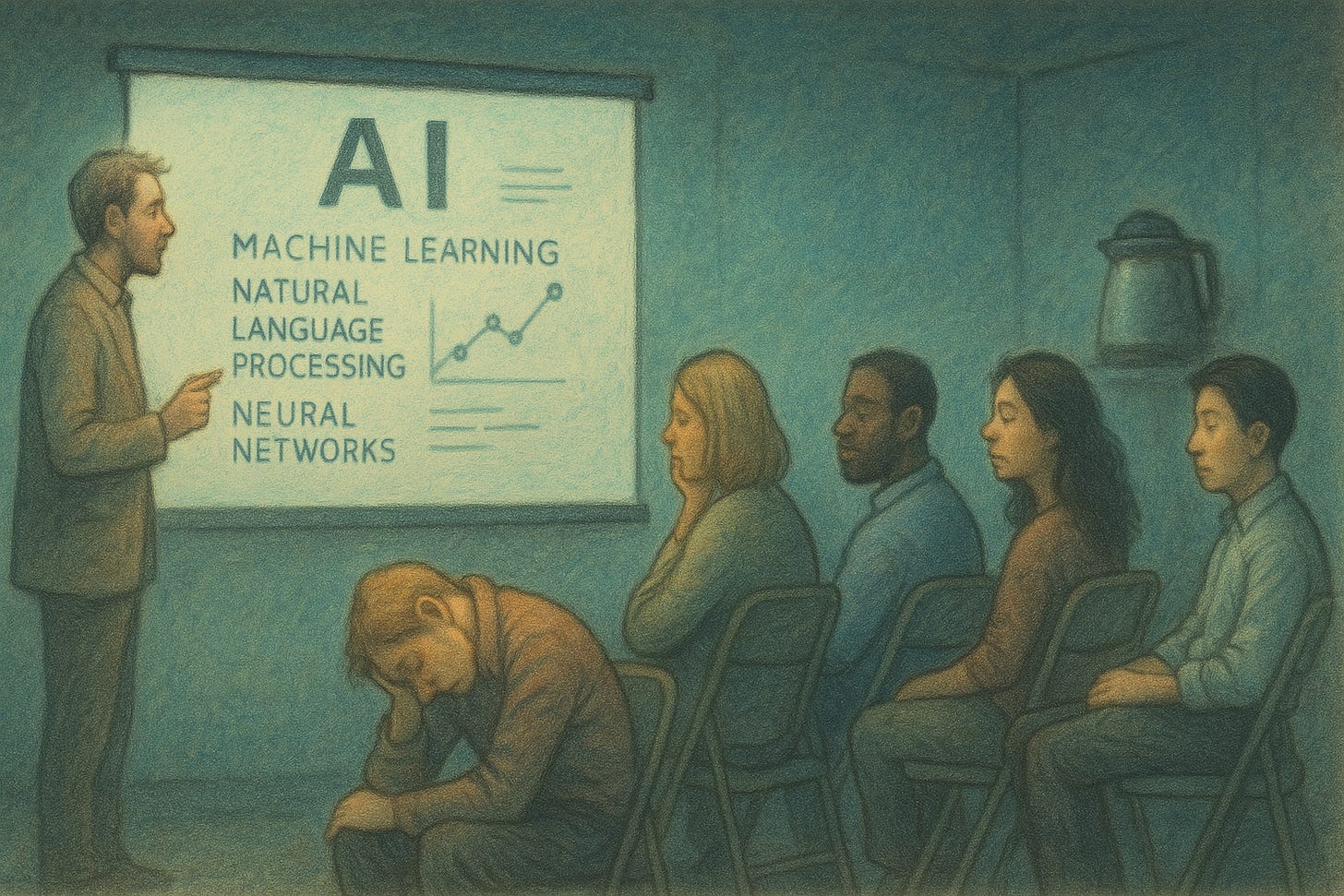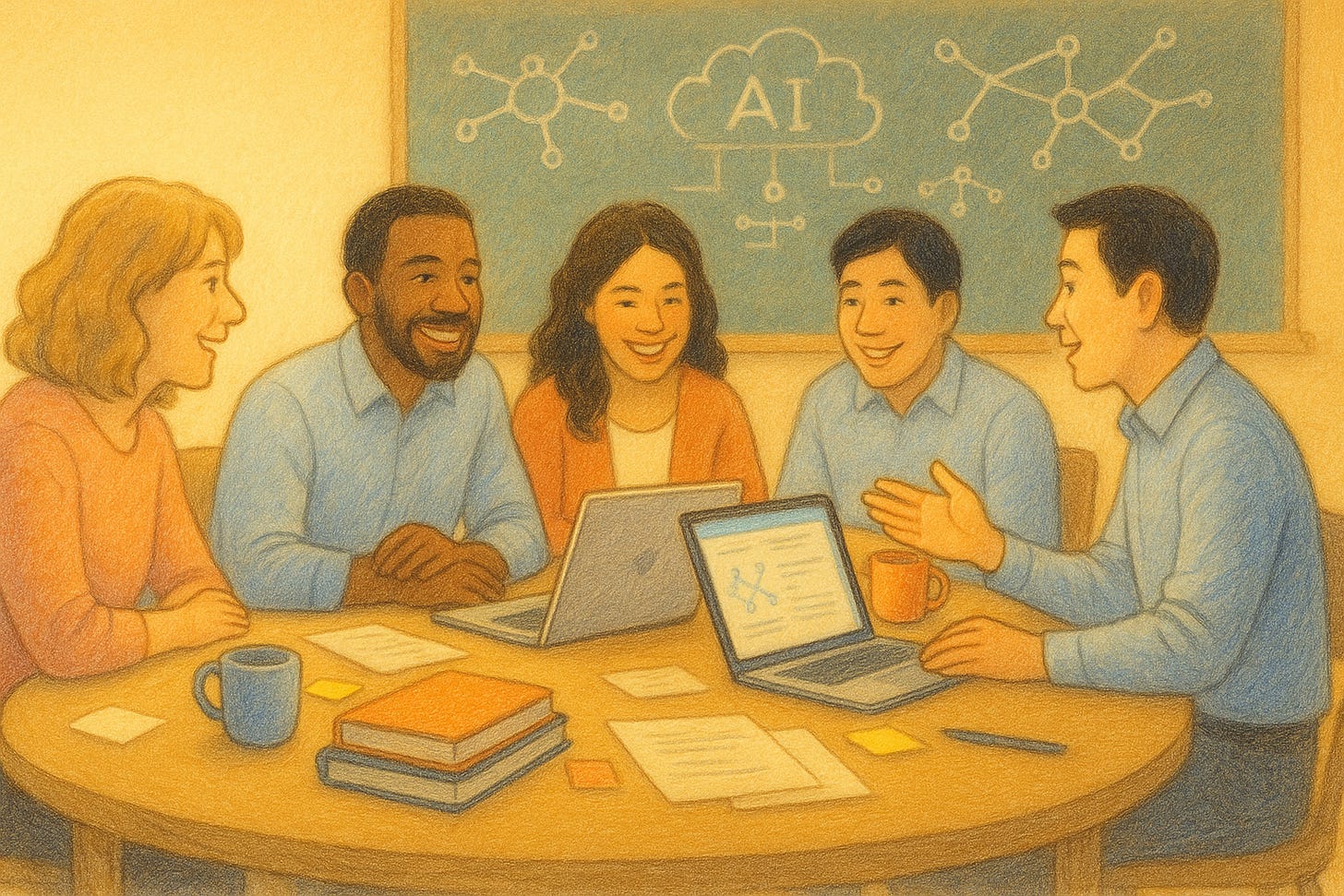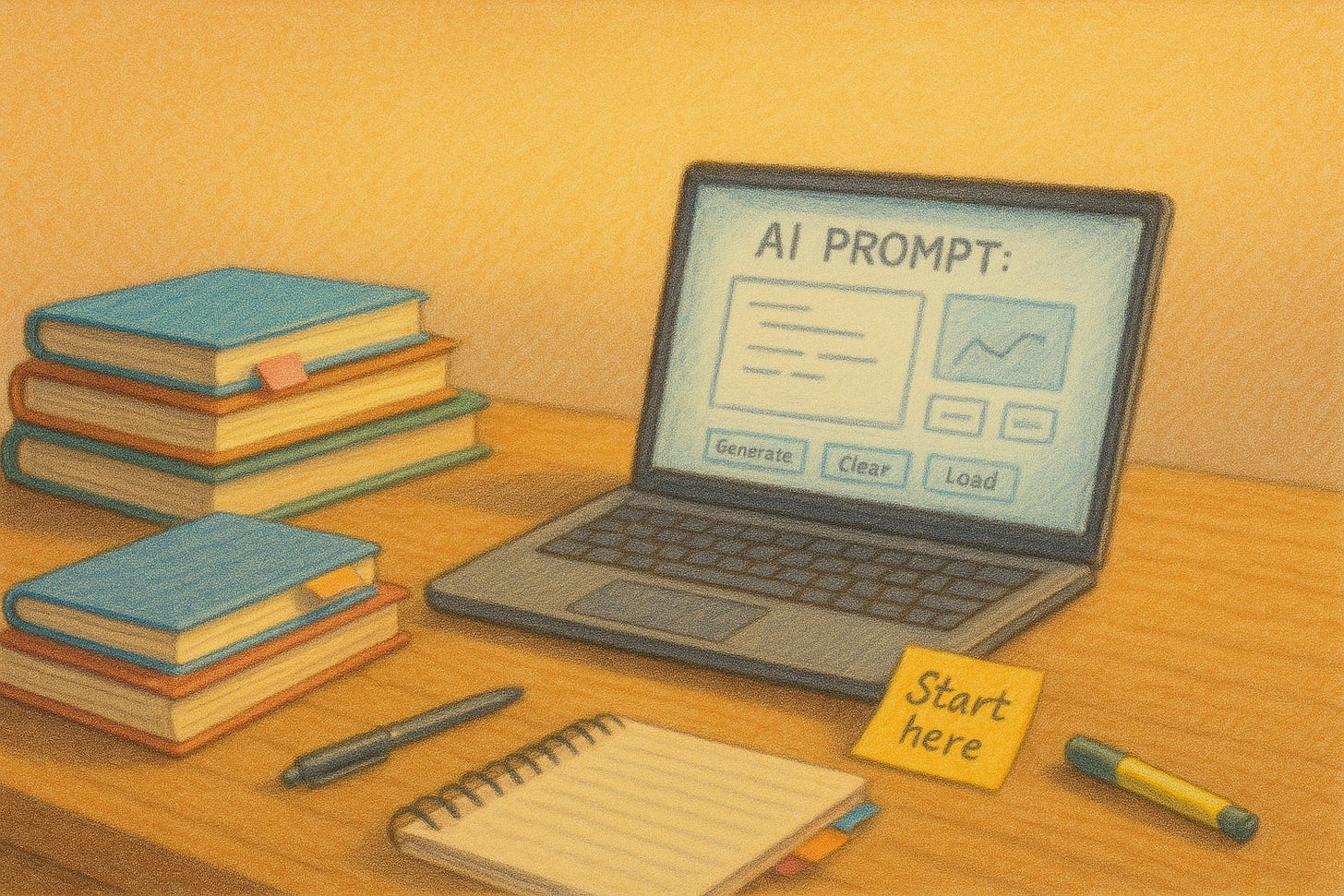A Teacher's Guide to Making AI PD Matter
We don’t need more slides. We need support, skill, and a seat at the table.
With AI now an educational emergency, the common refrain from teachers is “we need more training!” Yet, what most of us experience as “professional development” rarely justifies the time invested. Even a useful PD is just an adequate one-off where you might pick up a single new pedagogical strategy. Few PD days actually challenge - and change - how you think about teaching. Who exactly is going to conduct AI training and what does effective training even look like? As administrators start planning for fall AI workshops, how can we make sure that they count?
Training Will Not Be A Magic Bullet
Teachers are already juggling multiple initiatives, and for many, AI doesn’t feel like the most urgent one. If we expect everyone to engage with it seriously, we need to give them a reason to show up.
I’ve been teaching since 1995 and have attended dozens of conferences, workshops, institutes and webinars over the years. I’ve run quite a few myself. I can usually tell within 5 minutes whether it’s going to be worth my time. Maybe two or three were truly transformative.
The best PD doesn’t just give you something useful for Monday. It gives you something to keep thinking about every day after that.
It crosses disciplines, informs your practice, and rewires how you see your students. Ideally, it creates a new community of educators committed to exploring and evolving their practice together.1
One I still think about was a workshop in the mid-90’s with Dr. Michael Thompson, co-author of Raising Cain2. He broke down the emotional lives of middle schoolers with such brutal clarity that it permanently changed how I approached teaching that age. When a seventh-grade girl gets exiled by her entire friend group at lunch, she’s not going to care about the Holy Roman Empire at 1pm. If you can’t recognize that, you’re not suited to teach middle school. That session gave me a lens that became even more valuable as teen social lives migrated online.
That’s the kind of immersive framing AI PD needs to aim for. Yes, teachers need to learn AI tools, use cases, and hands-on practice. But that’s not enough. A serious AI workshop must push educators to reconsider our assumptions about thinking, assessment, and the human parts of learning that can’t - or shouldn’t - be automated. That’s a tall order given the typical time constraints of in-service training. But it’s the conversation we desperately need to have.
What makes good PD stick?
Ask any veteran teacher and they will say that great PD has elements of these five things:
it is inspired by passionate, knowledgable, and energetic presenters who not only know their stuff but can speak from experience working with students and teachers; not some industry insider or corporate shill.
it creates a paradigm shift in thinking about educational practice that is not discipline or division specific; it makes you rethink how you teach, not just what you teach.
it includes hands-on activities and demonstrations; above all, it demands engagement and is designed for learning.
it provides high-quality materials and resources thoughtfully curated; not links to PowerPoints you’ll never open, but lessons, readings, and insights you will actually use.
it offers on-going support and a realistic path forward.
That last one’s rare. Most PDs are one-and-done. Best case scenario is an initial burst of excitement, but then it’a almost always back to business as usual.
With AI, there is no back to business as usual. We need to stop treating it like just another new tool. AI is already reshaping how students learn, how they write and, increasingly, how they think.
AI PD Don’ts (Admins Should Take Notes)
Don’t bring in someone with ties to the AI industrial complex. If they’ve never taught a class or don’t work primarily with teachers and students, they aren’t going to connect beyond pitching their product or really understand the demands of running a classroom.
Don’t make it a lecture. Slide decks can be more or less engaging depending on the speaker, but the day has to include hands on exposure and use of what everyone is talking about. If you don’t see AI in action, it’s hard to understand its implications.
Don’t go in blind. Figure out what your faculty already knows and how they feel. If half your teachers haven’t opened ChatGPT and the other half are building GPTs, that’s not one audience. Teachers have strong, often conflicting views about AI. Gather that intel beforehand so the PD can be calibrated to meet people where they actually are.
What If We Got AI PD Right?
Let’s start with the obvious: it can’t just be doom or hype. We don’t want to spend a day throwing up our hands in existential despair about cheating or accepting uncritically the narrative that AI is “inevitable” in schools. But we have to treat it as a present technology. It’s not the calculator but it’s not the Matrix either.
Teachers need something practical and inspiring. Effective AI PD needs to be grounded in reality, but with a real vision.
A Potential PD Structure That Works
The Importance of Framing
The foremost of human faculties is the power of thinking. The power of thinking can be assisted either by bodily aids or by mental aids.
—Gottfried Wilhelm Leibniz, On the Organon or Great Art of Thinking, 16793
A meaningful AI PD isn’t about showing off the latest cool tools. It needs to reframe the current moment so that it’s not just about AI, but about what AI represents to the learning process - both the threats and opportunities. A quote like the one above may bring together the skeptics and the optimists. Who can argue about the importance of preserving thinking? Or the fact that humans have been grappling with these questions for centuries? Folding the AI conversation into the larger historical narrative about the human trade offs with all technologies may lower the temperature around the intense feelings people have about AI’s impact in schools.
5 Things Every AI PD Needs to Cover
What AI Actually Is (and Isn’t)
Any opening AI PD for a general audience of educators has to assume very little. AI isn’t magic even if it sometimes seems like it. It’s prediction at scale. A lot of PD is wasted on jargon and terminology. Instead, show how a chatbot responds in real time to actual teacher prompts. Let people see the limitations as well as the strengths. Don’t get lost in the history of how generative AI developed. It’s also a great way to show the latest models in context.
Show, Don’t Tell — Real Use Cases
Teachers don’t need another lengthy slideshow. They need to see examples of how AI works in an academic setting. Customized Projects. Research tools. NotebookLM. Pick two or three and try not to overwhelm. The goal is to show novices what’s out there and invite experienced users to share their stories.
If you’re building a PD day, you need a few go-to demos. I put together a short cheat sheet of real examples that have worked well in training sessions.
Have Teachers Work on Something Relevant to Them
Every teacher should come away with a tangible, actionable use case of AI they created. Give them time to build a lesson, prototype a new workflow, or design an assignment using an AI tool. This needs tight planning, advanced setup (so time isn’t wasted with technical glitches like account creation, wi-fi and passwords). Establishing clear instructions and goals is a must.
When NOT to Use AI, the Preservation of Human Learning, and the Costs of Progress
It’s essential to give space for teachers to share their misgivings, fears, objections, and doubts about new generative AI technologies. But we need solutions not just hand-wringing. What we need to focus on is what’s under our control. What’s worth protecting? When does AI flatten thinking? When does it widen gaps? Let’s re-emphasize where human connection and autonomy matter most and find ways to ensure AI doesn’t intrude.
Debrief and Next Steps
Create time for teachers to share anything they need to about the session, but most importantly, make it clear that AI awareness is not simply a one off. Provide resources and links for teachers to do what they should do best - activate their life-long learning tendencies. If learning more about how to use AI is the goal, every AI model and platform has YouTube videos, tutorials, and instructional sites where a motivated teacher can level up their skill. Want to read more about the history of generative AI, where it’s been and where it’s heading? The bias, hallucinations and environmental impacts? Or the risks and concerns about cognitive off-loading and danger of over-reliance on AI?
There are ample resources on all these topics that can be made accessible for teachers in an easy to navigate online shared document.
And Let’s Be Real About Time
A full-day PD means maybe 4 to 6 hours, tops. Many schools schedule PD’s haphazardly and break up the day into multiple sessions with multiple goals, trying to serve the needs of different constituencies. Even with 6 hour’s of PD, you’re only going to scratch the surface.
But a strong opening session can set the stage.
An initial AI PD can start a culture shift. Deliver a session that acknowledges the reality teachers are facing, while also showing what’s possible. Then build in follow-up. Office hours. Drop-In Sessions. Offer real support tailored to your school and not a canned AI curriculum built by people who don’t know your students.
An AI PD isn’t just about AI as “a new learning tool.” It’s about understanding how the ground beneath our profession is shifting while the students are already there.
Final Thoughts
AI’s impact on learning needs to be an ongoing conversation. We need to achieve a baseline competence with the tools because a world infused with AI is here now, regardless of whether you lean more towards AI Will Be A Normal Technology or we will see AGI by 2027. Teachers cannot passively acquiesce and succumb to what’s happening around us. A worthwhile goal of AI PD is to empower teachers to reclaim the narrative around AI, equip them with skills to recognize and understand AI technologies, and do what they do best which is to exercise human judgment about whether and how technology can, paraphrasing Leibniz, “assist human thinking.”
For a great example of this kind of grass-roots, teacher-led AI PD, check out the most recent post on The Important Work. It proves that these sessions don’t have to be theoretical. They’re already starting to happen.
Thompson is a clinical psychologist who was talking about the fragility of male emotional development well before books like Richard Reeves Of Boys and Men: Why the Modern Male Is Struggling, Why It Matters, and What to Do about It gave it renewed urgency.
I got this quote from an excellent new substack post from Maria Weaver, The Thinking Person's Guide to Not Getting Dumber with AI - a great piece to assign before any AI workshop!







Excellent again Stephen. I must have sat through a similar number of PD sessions and I certainly agree that fewer slides is definitely a step in the right direction. If it ends with no slides, I'm probably happy.
Justin Reich is surely right in 'Failure to Disrupt' when he suggests that real change has to be incremental and it has to come from the ground up. In my experience, teachers are inspired to make changes to their practice when they see someone close by doing something that clearly works.
That used to mean someone in your own school, even department. It doesn't now - many of us are happy building learning networks that cover much greater geographical distance - but it's still important to find people who are open, honest and who work with humility. I think Substack is the best place for that at the moment and reading your work and the work of others who are thinking deeply about these questions is a crucial part of my PD at the moment.
Great work, Stephen. You are really hitting your stride now on Substack. Your voice and perspective are clear and practical. Such a gift to the community!